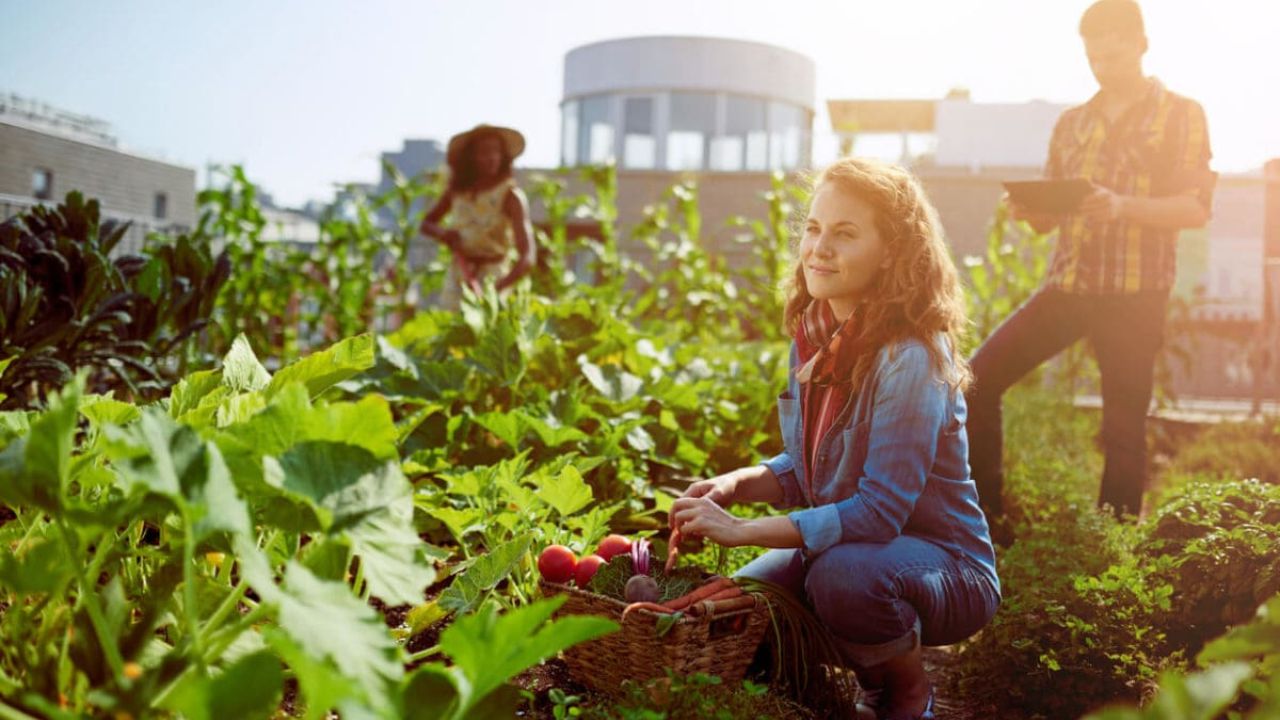
Urban farming is changing how we get our food in cities. As a result, As more people move to cities, the need for fresh food grows. This has caused urban agriculture to become popular.
Urban agriculture is when people grow food in the city, like on rooftops, in small gardens, or even on walls. It helps people get fresh, healthy food close to home. With less space to grow food, finding new ways to farm in cities is important.
Urbanization, or the growth of cities, has made it harder to get fresh food. Many people in cities rely on stores for food, but this food often travels long distances.
Urban farming helps solve this problem. It cuts down on food miles, which means the food doesn’t need to travel as far. This is good for the environment because it reduces pollution. It also means the food is fresher and healthier when it reaches your plate.
More and more city dwellers are turning to urban farming for these reasons. By growing food right where they live, people have more control over what they eat. It also encourages healthier eating habits, as the food is usually organic and free of chemicals. Urban farming is also helping fight food deserts—places in cities where fresh food is hard to find. So, as cities grow, urban farming is showing us a better, greener way to eat.
What is Urban Farming?
Urban farming is when people grow food in the city, For example, this can be done on rooftops, in small gardens, or even on walls. In other words, urban farming happens right where people live. This means food can be grown on rooftops, in small gardens, or even inside buildings. It’s a new way to bring fresh food to city areas, helping people get healthy food without going far.
Urban farming is a modern approach to agriculture. Instead of needing large fields, urban farmers use any available space. This can be a tiny balcony, a rooftop, or a backyard. People grow fruits, vegetables, and herbs, and sometimes even raise animals like chickens or fish. Because space is limited in cities, urban farmers have to get creative with how they grow food. This makes urban farming different from traditional farming, but it’s just as important.
There are many types of urban farming. One popular method is rooftop gardens. These gardens sit on top of buildings and use space that would normally go to waste. People plant vegetables, herbs, or even flowers on rooftops, turning unused areas into green spaces.
Another exciting type is vertical farming. Vertical farms grow plants in tall stacks or shelves, using layers to maximize space. This way, farmers can grow a lot of food in a small area, making vertical farming perfect for crowded cities.
Urban farming helps reduce the need to transport food long distances, which means fresher produce and less pollution. It also teaches people about growing their food and encourages healthier eating habits. As urban farming continues to thrive, innovative solutions like custom storage tanks can play a vital role in maximizing space and resources. These tanks not only support efficient water management for urban gardens but also contribute to sustainable practices within city farming initiatives. As cities grow, urban farming will become more important in making sure everyone has access to fresh, healthy food.
The Benefits of Urban Farming in Cities
Urban farming brings many benefits to cities. It helps people get fresher, healthier food while also protecting the environment. Growing food in the city makes life better for everyone. Here are some of the main benefits:
Fresher, Healthier Produce in Urban Areas
Urban farming allows people to grow food close to where they live. Additionally, this means fruits and vegetables don’t have to travel far to reach your plate. The shorter distance means the food is fresher and tastes better. Since it’s often picked right before it’s eaten, urban farming gives you healthier food filled with nutrients. It also encourages people to eat more fruits and vegetables, leading to better health.
Reducing the Carbon Footprint of Food Transportation
When food is grown far away, it needs to travel long distances in trucks, planes, or ships. This causes pollution, which harms the environment. Urban farming cuts down the need for transporting food because it’s grown right in the city. With less travel, there’s less pollution and fewer greenhouse gases. This helps the planet and makes cities cleaner.
Building Local Food Security and Resilience
Urban farming helps cities become more independent. Instead of relying on food from faraway farms, people can grow their produce right in the city. This is especially helpful during emergencies or food shortages. It makes sure that fresh food is always available nearby.
Urban farming also builds strong communities. Neighbors can work together, share food, and learn how to grow their own. This creates a sense of teamwork and resilience.
In summary, urban farming brings fresher food, reduces pollution, and makes cities more self-reliant. It’s a way to eat healthier while helping the planet.
How Urban Farming is Transforming Eating Habits
Urban farming is changing the way people in cities eat. By growing food close to home, it brings fresh and healthy options to everyone. It also encourages people to eat in ways that are better for the planet. Here are some ways urban farming is transforming eating habits:
Connecting City Dwellers with Fresh, Organic Food
Urban farming makes it easy for people in cities to get fresh, organic food. Moreover, Many city dwellers are used to buying food from supermarkets, where fruits and vegetables may not be as fresh. But with urban farms, people can eat food that’s picked on the same day. It’s also often organic, meaning it’s grown without chemicals. This makes the food healthier and tastier.
Promoting Plant-Based Diets and Sustainability
Urban farming encourages people to eat more plant-based foods. Since many urban farms focus on growing vegetables, herbs, and fruits, they make plant-based eating easier and more appealing.
Eating more plants is good for your health and helps the environment too. In addition, Growing plants use less water and energy than raising animals for food. This makes plant-based diets a more sustainable option for the planet.
Supporting Farm-to-Table Movements in Restaurants
Urban farming is also helping restaurants serve fresher food. Many restaurants in cities are part of the farm-to-table movement. This means they use food that’s grown locally, sometimes even in the city. By getting food from urban farms, restaurants can serve dishes with fresher ingredients. This is great for people who want to eat healthy, local food when they dine out.
In short, urban farming is making it easier for city people to eat fresh, healthy, and sustainable food. It’s changing the way we think about what we eat and where it comes from.
Urban Farming’s Role in Addressing Food Deserts
Urban farming is addressing a major issue in some city areas known as “food deserts.” Food deserts are places where people struggle to find fresh fruits and vegetables and often rely on unhealthy foods. By growing food within these communities, urban farming is bringing healthier options directly to those who need them.
Instead of traveling long distances or paying high prices for fresh produce, Consequently, residents can now access it right in their neighborhoods. Urban farms, often set up in empty lots or on rooftops, make it easier for people to eat better and live healthier lives.
In food deserts, fresh produce is hard to come by, leaving many people with only fast food or processed snacks as options. Urban farming changes this by making fruits and vegetables readily available within the community.
This shift means that residents no longer have to go out of their way or pay extra for healthy food. By growing produce locally, urban farms help to make healthy food accessible and affordable for everyone.
Food insecurity, the uncertainty about where the next meal will come from, is another problem urban farming helps solve. Many city residents struggle with the cost and availability of nutritious food. Urban farms address this issue by offering a consistent supply of fresh, affordable produce. Some urban farms even distribute food for free or at lower prices, helping those who cannot afford expensive groceries.
Additionally, these farms often teach people how to grow their food, which can further reduce food insecurity and give people more control over their meals. Overall, urban farming plays a crucial role in combating food deserts and improving food security in cities.
Innovative Urban Farming Techniques
Urban farming is getting creative with new techniques. These methods help people grow food even in small spaces and without traditional soil. Here are some innovative techniques that are changing how we farm in cities:
Hydroponics and Aquaponics: Farming Without Soil
Hydroponics and aquaponics are cool ways to grow plants without using soil. One such method is vertical farming, which uses tall stacks or shelves to grow plants in layers. In hydroponics, plants grow in a special water solution that has all the nutrients they need. This method is great for city farms because it takes up less space and can be used indoors.
Aquaponics is a bit different. It combines fish farming with growing plants. The fish produce waste that provides nutrients for the plants, and the plants help clean the water for the fish. Both methods help save space and resources while growing healthy food.
Vertical Farming: Maximizing Small Spaces for Big Yields
Vertical farming is another smart technique. It uses tall stacks or shelves to grow plants in layers. This means you can grow a lot of food in a small area.
For example, instead of spreading outcrops on a large field, vertical farms stack plants on top of each other. This is perfect for city rooftops or inside buildings where space is limited. Vertical farming makes the most of every inch, allowing cities to produce more food without needing extra land.
Community Gardens: Empowering Neighbors to Grow Together
Community gardens bring neighbors together to grow food. These gardens are often shared spaces where people can plant and harvest fruits and vegetables.
Everyone works together, which makes gardening fun and social. Community gardens help people learn how to grow their food and connect with others in their area. They also provide fresh produce for the whole neighborhood, making healthy food more accessible.
Challenges of Urban Farming
Urban farming is a fantastic way to bring fresh food to city areas, but it also comes with its own set of challenges. Despite these challenges, many are working hard to find solutions. As cities grow and become more crowded, urban farmers face several obstacles in their quest to grow food in these bustling environments. Despite these hurdles, many are working hard to find solutions and make urban farming a successful and sustainable practice.
- Finding adequate space in crowded cities is difficult.
- Even when space is available, it often comes with a high price tag.
- Urban farmers must use creative solutions, like rooftops or small lots, to grow food.
- Cities have complex zoning laws that control land use.
- Some zoning rules may restrict or prohibit farming activities.
- Obtaining special permits or approvals can be a time-consuming process.
- Urban farmers need tools, seeds, and knowledge to be successful.
- Finding local sources for these resources or training can be challenging.
- Limited access to farming supplies and education can hinder farming efforts.
The Future of Urban Farming and Its Impact on City Life
Urban farming is not just changing how we grow food today; it’s also shaping the future of city life. Looking ahead, technological innovations and city planning will play a big role in its development. Let’s explore what’s coming next for urban farming and how it might impact cities.
Technological Innovations Shaping Urban Farming
New technologies are making urban farming better and more efficient. For example, smart sensors can help farmers know exactly when to water their plants. Vertical farming uses special lights and systems to grow plants in stacked layers, saving space. Drones can even monitor crops from above. These technologies make farming in cities easier and more productive.
Integrating Urban Farming into City Planning
Cities are starting to include urban farming in their plans. This means they are designing new buildings and parks with space for gardens and farms. Some cities are adding green roofs where people can grow their vegetables. By planning for urban farming, cities can create more green spaces and make it easier for people to access fresh food.
How Urban Farms Can Influence Sustainable Urban Development
Urban farms can help cities become more eco-friendly. They reduce the need for food to travel long distances, which cuts down on pollution from transportation. Growing food locally also helps reduce waste, as food doesn’t need to be packaged and shipped. Urban farms can make cities healthier and more sustainable places to live.
Conclusion
Urban farming is a growing trend that is changing the way we eat in cities. By bringing fresh, healthy food right to our neighborhoods, in conclusion, urban farming makes cities healthier places to live. We can now enjoy fruits and vegetables grown close to home, and this helps us eat better and feel better.
Moreover, Urban farming isn’t just a trend; it’s a movement towards a greener, more sustainable future. Cities are becoming smarter by including farms in their plans and using cool new technologies. This helps reduce pollution and makes our cities more eco-friendly.
You can be a part of this change too! Start by supporting urban farms in your city. Visit local farms, share their stories, or even grow your plants at home. If you want to help, you can also talk to your city leaders about adding more green spaces and community gardens.
We’d love to hear what you think! Please leave a comment below and share this amazing information with your friends. Together, we can help make our cities healthier and greener places to live.







